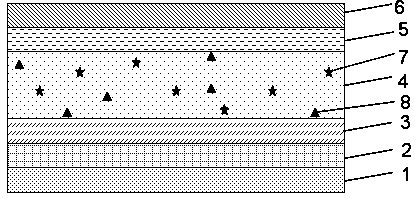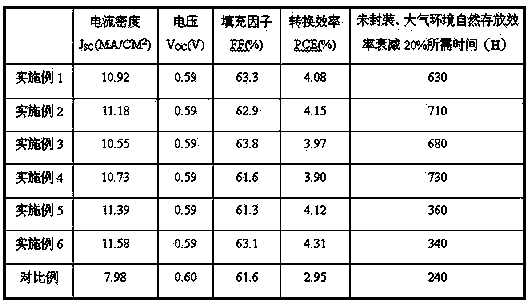Organic solar cell
A solar cell, organic technology, applied in circuits, photovoltaic power generation, electrical components, etc., can solve the problems of low crystallinity of the photoactive layer film, unable to form effective current, poor stability, etc., to improve photoelectric conversion efficiency and enhance utilization efficiency. , the effect of improving the crystallinity
- Summary
- Abstract
- Description
- Claims
- Application Information
AI Technical Summary
Problems solved by technology
Method used
Image
Examples
Embodiment 1
[0034] Treatment of transparent G / ITO:
[0035] After etching the electrode pattern on ITO conductive glass (Zhuhai Kaiwei Electronic Components Co., Ltd., square resistance 14Ω / □, transmittance 85%), wash it with detergent, and then use deionized water, absolute ethanol, acetone and isopropyl Alcohol ultrasonic cleaning for 10 minutes, nitrogen drying, and UV / ozone treatment for 20 minutes.
[0036] Preparation of electron transport layer:
[0037] A layer of ZnO with a thickness of 20nm was prepared on the surface of ITO by magnetron sputtering.
[0038] Preparation of photoactive layer:
[0039] Weigh 15mg P3HT and 15mg PC respectively 60 BM was dissolved in 1mL of chlorobenzene, and then 0.2mg ZnTPP and 0.02mg CuPc were added, ultrasonic treatment for 0.5h, magnetic stirring at 70℃ for 4h, and then the mixed solution was spin-coated on the surface of the electron transport layer by a homogenizer. The homogenizer rotates at 1000 rpm, spin-coating for 40 seconds, and annealing at 13...
Embodiment 2
[0046] Preparation of photoactive layer:
[0047] Weigh 15mg P3HT and 15mg PC respectively 60 BM was dissolved in 1 mL of chlorobenzene, and then a solution of 0.01 mg ZnTPP and 0.02 mg SiPc was added, ultrasonicated for 0.5 h, magnetically stirred at 70 °C for 4 h, and then the mixed solution was spin-coated on a homogenizer. The homogenizer rotates at 1000 rpm, spin-coats for 40 seconds, and anneals at 130° C. for 10 minutes to prepare a photoactive layer film with a thickness of 200 nm.
[0048] Other preparation methods are the same as in Example 1.
[0049] The device structure of the organic solar cell prepared by the above method: G / ITO / ZnO / P3HT:PC 60 BM: ZnTPP: SiPc / MoO 3 / Al, effective area is 0.04cm 2 , The photoelectric conversion efficiency data is shown in Table 1, and the test conditions are the same as in Example 1.
Embodiment 3
[0051] Preparation of photoactive layer:
[0052] Weigh 15mg P3HT and 15mg PC respectively 60 BM was dissolved in 1 mL of chlorobenzene, then a solution of 1.0 mg N3 and 0.1 mg SiNc was added, sonicated for 0.5 h, magnetically stirred at 70 °C for 4 h, and then the mixed solution was spin-coated on a homogenizer. The homogenizer rotates at 1000 rpm, spin-coats for 40 seconds, and anneals at 130° C. for 10 minutes to prepare a photoactive layer film with a thickness of 200 nm.
[0053] Other preparation methods are the same as in Example 1.
[0054] The device structure of the organic solar cell prepared by the above method: G / ITO / ZnO / P3HT:PC 60 BM: N3: SiNc / MoO 3 / Al, effective area is 0.04cm 2 , The photoelectric conversion efficiency data is shown in Table 1, and the test conditions are the same as in Example 1.
PUM
 Login to View More
Login to View More Abstract
Description
Claims
Application Information
 Login to View More
Login to View More - R&D
- Intellectual Property
- Life Sciences
- Materials
- Tech Scout
- Unparalleled Data Quality
- Higher Quality Content
- 60% Fewer Hallucinations
Browse by: Latest US Patents, China's latest patents, Technical Efficacy Thesaurus, Application Domain, Technology Topic, Popular Technical Reports.
© 2025 PatSnap. All rights reserved.Legal|Privacy policy|Modern Slavery Act Transparency Statement|Sitemap|About US| Contact US: help@patsnap.com


